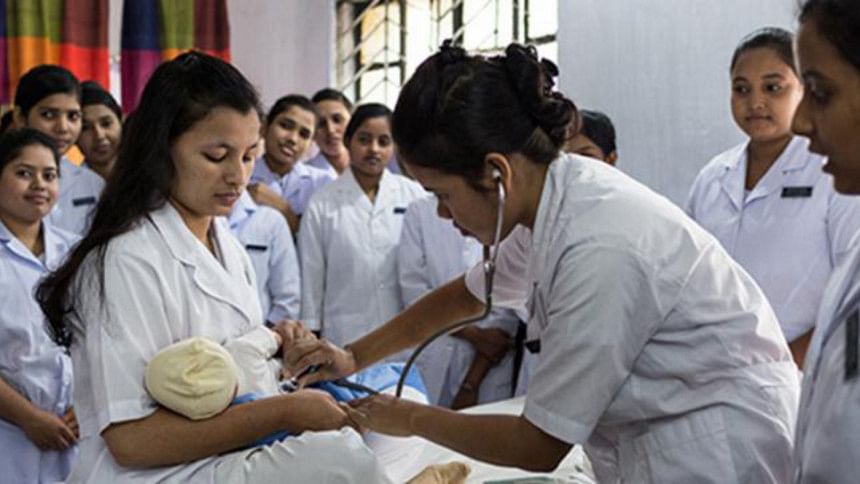Midwifery education in the private sector: The hurdles along the way

Among many bold initiatives taken by Prime Minister Sheikh Hasina's government, introducing midwifery in Bangladesh's health system is one of the most significant ones. The country did well in terms of reducing maternal mortality during the MDG era, but latest research reports of a stall in its further progress.
Between 2010 and 2016, the maternal mortality ratio (MMR) showed no further improvement. For the development agenda in the health sector to succeed, promotion of midwifery as an independent profession is the right step. Over the past few years, contributions have been made to further this agenda. A three-year diploma programme—designed according to international standards—was introduced in 38 government training centres and 17 private institutes from January 2013. As of now, 2,131 graduate midwives have earned midwifery licenses through examinations conducted by the Bangladesh Nursing and Midwifery Council (BNMC). Almost all of the licensed midwives are currently employed either in the government or in the private sector, while many are also serving in the Rohingya camps.
The non-governmental sector also came forward to supplement the efforts of the government in training midwives and promoting the midwifery profession. These institutes, which are located in many disadvantaged corners of the country, have already earned a reputation in providing quality education and have produced 461 licensed midwives so far. As a matter of fact, the midwife who topped the latest nationally conducted licensing examination came from one such institute. Unfortunately, there are a few issues and constraints for which midwifery institutes in the private sector are suffering to a large extent.
An order from the High Court has put a stay on the licensing exam that was supposed to take place last February.
Midwifery is a relatively new profession in Bangladesh. There is hardly any specially trained faculty available in the country. The initial need is being met by recruiting nurses who receive only the basic orientation on midwifery during their nursing education. Some institutions are employing their own-trained diploma-holding midwives as junior faculty as a stopgap measure.
This would not have been an issue if the government had agreed on the curricula for a BSc programme in midwifery. Allowing universities to introduce undergraduate programmes on midwifery would solve the faculty shortage issue at least in the short term. Moreover, it is learnt that the government is proposing a two-year bridging BSc for graduated midwives with diplomas. But it would be unfair to them because they are spending three intensive years of learning after their HSC to complete the diploma. Hence they should be allowed to do it in just one year. This is the standard practice in many other countries which Bangladesh should also follow. In addition, the government should encourage universities, both public and private, to develop and run full-length four-year undergraduate courses on midwifery. The latter will help establish midwifery as an independent profession along with meeting the faculty shortage problem.
Another hurdle for the private sector investors is the huge amount of money they are asked to deposit to open a midwifery institution—a sum of Tk 25 lakh as a deposit. This, along with a 30,000 square ft floor space and ensuring residential facilities with an ability to accommodate all students, are unnecessary demands that should not be imposed. These demands will discourage many entrepreneurs from establishing any such institute. Besides, no other institution is enforced to meet such prerequisites. An equivalent nursing institute, for example, needs only Tk 15 lakh as a deposit.
Some of the existing private midwifery institutions are already facing severe resource constraints because their only source of revenue is the tuition fee. Charging higher fees is also not an option due to the average financial ability of the commoners. So, the government should consider subsidising the private midwifery institutes rather than subjecting them to these restricting rules.
Last but not least, a recent government decision to hold a centralised admission exam for all students entering midwifery programmes in both public and private sectors is a discriminatory act against private institutes. As the government's own institutes offer diplomas free of cost, all the top-notch candidates naturally tend to join government institutes. So, private institutes are left with those in the bottom of the list. This is not fair and the government should allow the private institutes to recruit students directly.
The government's initiatives in achieving the Sustainable Development Goals (SDGs) will be at risk if the private sector is unable to deliver to their best extent. The midwifery education programme is a good example in this respect. The private sector institutes have proved their worth in training competent midwives and it would be a missed opportunity if we don't make the best use of it. The government should come forward and remove all the obstacles and bottlenecks faced by these institutes so that this commendable and critical step of theirs is not compromised.
Mushtaque Chowdhury and Selina Amin are, respectively, adviser and director of the Developing Midwives Project at BRAC University James P Grant School of Public Health.
Follow The Daily Star Opinion on Facebook for the latest opinions, commentaries and analyses by experts and professionals.
To contribute your article or letter to The Daily Star Opinion, see our guidelines for submission.

 For all latest news, follow The Daily Star's Google News channel.
For all latest news, follow The Daily Star's Google News channel. 



Comments